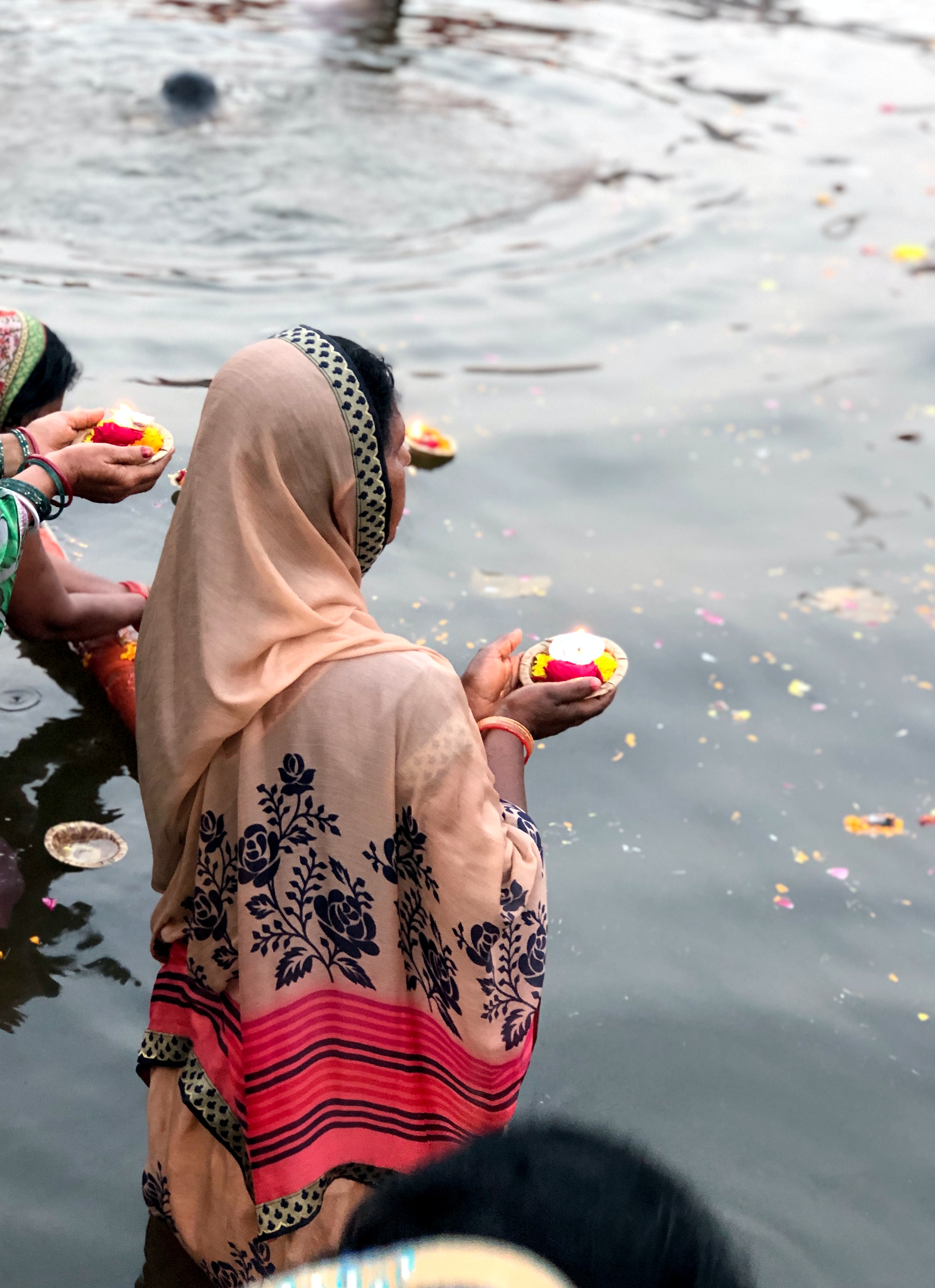The Ganges River, often known as the Ganga, is a river in northern
India that flows toward the Bangladesh border. It is India's longest
river, flowing 1,569 miles (2,525 kilometres) from the Himalayan
Mountains to the Bay of Bengal. The river has the world's second highest
water output, and its basin is the most densely populated, with over
400 million people living there.
The Ganges
River is incredibly significant to the people of India because the
majority of the people who live on its banks rely on it for daily needs
such as bathing and fishing. It is extremely significant to Hindus, who
regard it as their most sacred river.
by pop & zebra - unsplash
The Course of the Ganges River
The Ganges River's headwaters are located in the Himalayan Mountains, where the Bhagirathi River pours out of the Gangotri Glacier in India's Uttarakhand state. The glacier is 12,769 feet above sea level (3,892 m). The Ganges River proper originates further downstream at the confluence of the Bhagirathi and Alaknanda rivers. The Ganges creates a narrow, steep gorge as it flows out of the Himalayas.
North Indian River Plain
The Ganges River originates from the Himalayas at Rishikesh, where it flows into the Indo-Gangetic Plain. This region, also known as the North Indian River Plain, encompasses the majority of India's northern and eastern regions, as well as parts of Pakistan, Nepal, and Bangladesh. In addition to joining the Indo-Gangetic Plain in this region, a portion of the Ganges River is diverted to the Ganges Canal for irrigation in the state of Uttar Pradesh.
Changes Direction
As the Ganges River moves downstream, it changes course multiple times and is joined by numerous tributary rivers, including the Ramganga, Tamsa, and Gandaki Rivers, to mention a few. The Ganges River also passes through various cities and towns on its way downstream. Chunar, Kolkata, Mirzapur, and Varanasi are among them. Many Hindus travel to Varanasi to see the Ganges River since it is considered the holiest of towns. As a result, the city's culture is inextricably linked to the river, which is the most sacred river in Hinduism.
Flows Into Bay of Bengal
The Padma River is the primary branch of the Ganges River after it leaves India and enters Bangladesh. The Padma River is joined downstream by major rivers such as the Jamuna and Meghna. It takes on its name after joining the Meghna before flowing into the Bay of Bengal. However, before entering the Bay of Bengal, the river forms the world's largest delta, the Ganges Delta. This region is a 23,000-square-mile area of exceptionally fertile sediment-laden soil (59,000 sq km).
Complex Hydrology
It should be noted that the Ganges River route given in the preceding paragraphs is a broad description of the river's route from its headwaters at the confluence of the Bhagirathi and Alaknanda rivers to its mouth in the Bay of Bengal. The Ganges has a complicated hydrology, and depending on which tributary rivers are included, there are several different descriptions of its overall length and the size of its drainage basin. The Ganges River's most frequently acknowledged length is 1,569 miles (2,525 km), and its drainage basin is estimated to measure 416,990 square kilometres (1,080,000 sq km).
The Population of the Ganges River
Humans have lived in the Ganges River basin from ancient times. The region's original inhabitants belonged to the Harappan culture. Around the 2nd millennium BCE, they came into the Ganges River basin from the Indus River basin. The Gangetic Plain later became the centre of the Maurya Empire, and eventually the Mughal Empire. Megasthenes was the first European to address the Ganges River in his work Indica.
Source of Life
The Ganges River has become a source of life for the over 400 million people who live in its basin in modern times. They rely on the river for daily necessities like as drinking water and food, as well as irrigation and manufacturing. The Ganges River basin is now the world's most populous river basin. Its population density is approximately 1,000 persons per square mile (390 per sq km).
The Significance of the Ganges River
The Ganges River is immensely important to India's Hindu people for religious reasons in addition to providing drinking water and irrigating farms. The Ganges River is revered as the goddess Ganga Ma, or "Mother Ganges," and is regarded their most sacred river.
According to the Ganges Myth, the goddess Ganga descended from heaven to dwell in the Ganges River's waters to protect, purify, and return people who touched it to heaven. Every day, devout Hindus visit the river to offer flowers and food to Ganga. They also drink the water and take baths in the river to wash away their sins.
'Pitriloka,' the World of the Ancestors
Hindus believe that after death, the waters of the Ganges River are required to reach Pitriloka, the World of the Ancestors. As a result, Hindus bring their deceased to the river for cremation along its banks, and their ashes are then scattered in it. Corpses are also dumped into the river in some situations. Varanasi is the holiest city along the Ganges River, and many Hindus travel there to scatter the ashes of their loved ones in the river.
Along with everyday baths in the Ganges River and sacrifices to the goddess Ganga, there are significant religious festivals held in the river throughout the year, during which millions of people travel to bathe in order to be purified of their sins.
Pollution of the Ganges River
Despite the religious and daily importance of the Ganges River to the people of India, it is one of the world's most polluted rivers. The Ganges is polluted by both human and industrial waste as a result of India's fast expansion, as well as religious ceremonies. India has a population of about one billion people, 400 million of whom dwell in the Ganges River basin. As a result, a large portion of their garbage, including raw sewage, is discharged into the river. In addition, many people bathe in the river and use it to clean their laundry. The levels of faecal coliform bacteria around Varanasi are at least 3,000 times greater than what the World Health Organization considers safe (Hammer, 2007).
Little Regulation
Industrial practises in India are similarly unregulated, and as the population rises, so will these industries. Many tanneries, chemical industries, textile mills, distilleries, and slaughterhouses line the river, and many of them throw untreated and frequently poisonous waste into it. The Ganges water has been found to have high quantities of chromium sulphate, arsenic, cadmium, mercury, and sulfuric acid (Hammer, 2007).
In addition to human and industrial waste, various religious practises contribute to Ganges pollution. Hindus, for example, believe that people must bring offerings of food and other materials to Ganga, and as a result, these items are thrown into the river on a regular basis, and especially during religious ceremonies. Human remains are also frequently thrown into the river.
Ganga Action Plan
Rajiv Gandhi, India's prime minister, launched the Ganga Action Plan (GAP) in the late 1980s to clean up the Ganges River. The plan called for the closure of numerous highly polluting industrial enterprises along the river as well as money for the development of wastewater treatment facilities, but its efforts have fallen short because the plants are too small to handle the trash generated by such a huge population (Hammer, 2007). Many polluted industrial plants are also still dumping dangerous materials into the river.
Despite this pollution, the Ganges River remains essential to the Indian people as well as several species of plants and animals, including the Ganges River dolphin, a highly rare species of freshwater dolphin unique solely to that area. To discover more about the Ganges River, visit Smithsonian.com and read "A Prayer for the Ganges."

 Create and manage your profile
Create and manage your profile Refer an author and get bonus Learn more
Refer an author and get bonus Learn more Publish any lost and found belongings
Publish any lost and found belongings Connect with the authors & add your review comments
Connect with the authors & add your review comments Join us for Free to advertise for your business or
Contact-us for more details
Join us for Free to advertise for your business or
Contact-us for more details
 Join us for Free to publish your own blogs, articles or tutorials and get your
Benefits
Join us for Free to publish your own blogs, articles or tutorials and get your
Benefits


 1 like
1 like


